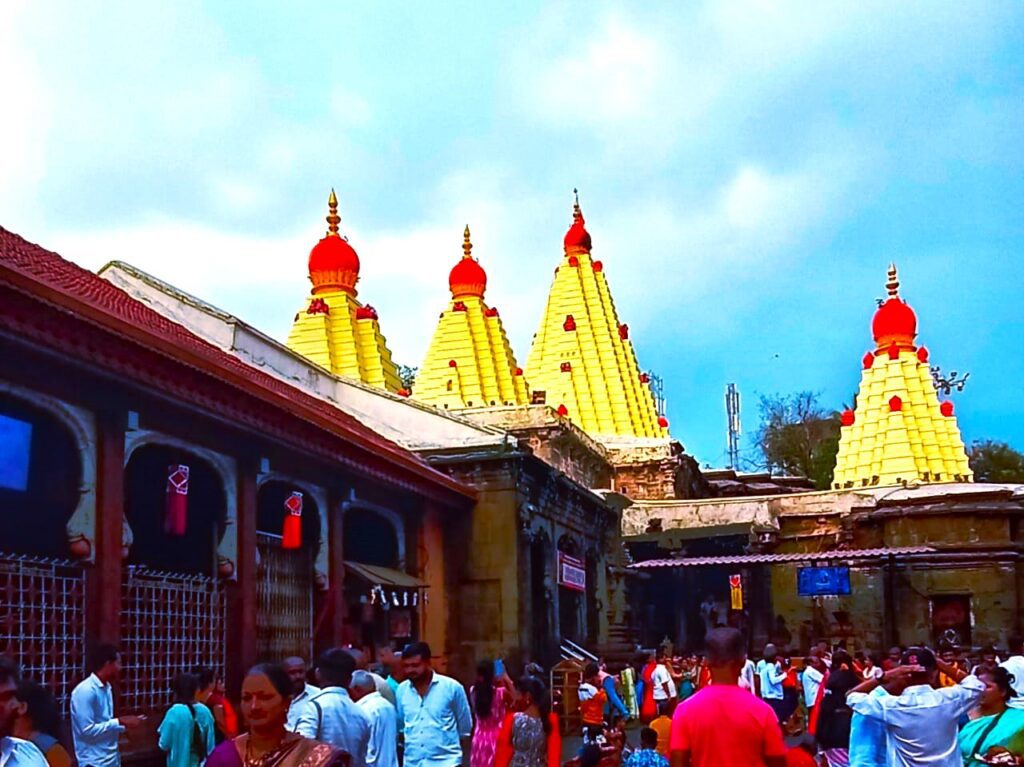
Mahalakshmi Temple
The Shree Mahalaxmi Temple, also known as the Mahalakshmi Temple or Ambabai Temple, is one of the most revered and significant Hindu temples in India. It is located in Kolhapur, Maharashtra.
Location: The temple is situated in the city of Kolhapur, in the southern part of Maharashtra. It is approximately 230 kilometers from Pune and 470 kilometers from Mumbai.
The Shree Mahalaxmi Temple is not only a spiritual destination but also a cultural landmark, reflecting the rich heritage and religious practices of the region. It remains a central part of the lives of many devotees and continues to be a major pilgrimage site.
About this Temple:
The temple is named after Ambabai/Mahalaxmi and is believed to be the residence of the divine couple. Architecturally, the temple belongs to the Chalukya empire and was likely first built around 700 AD. The statue of the four-armed, crowned goddess is made of sandstone and stands on a stone platform. This statue of Mahalaxmi, carved from black stone, is 2 feet 8.5 inches tall. In the temple, you can also find a Shri Yantra carved on a corner opposite to Mahakali. A stone lion, representing the goddess’s vehicle, stands behind the statue.
An inscription on a stone tablet, now in the town hall museum, mentions that in 1190, King Bhojadeva was peacefully ruling from Panhala. To ensure prosperity for his kingdom, he had the crown designed with images of the nag (serpent), ling (symbol of Shiva), and yoni (symbol of the goddess), representing time, creation, and the origin of the universe.
In the goddess’s four hands, she holds symbolic objects: a citrus fruit (mhalunga) in the lower right hand, a large mace (kaumodaki) in the upper right hand, a shield (khetaka) in the upper left hand, and a bowl (panpatra) in the lower left hand. Unlike most Hindu sacred images, which face north or east, this deity faces west (Pashchim). The rays of the setting sun shine directly on the idol’s face for three days each in late January and early February, and again in early November.
The temple courtyard also houses several other shrines, including those dedicated to Datta Mandir, Dkpalmandap, Navagrahas, Surya, Mahishasuramardini, Vitthal-Rakhmai, Krishna, Panchanganga, Swami Smarth Dashavatar, Ram Mandir, Sheshashai, Mahavishnu, Hanuman, Laxmi-Narayan, Khandoba, Atibaleshwar, Krishna, Kalbhairav, Sidhivinyak, Sinhwahini, Tulja Bhavani, Indrashabha, and Ek Mukhi Datta. Some of these images date back to the 11th century, while others are more recent.
Nearby, there was once a temple tank called Manikarnika Kund, which is now replaced by a garden.
Darshan And Kurma Mandap:
The Mahalakshmi Temple has two main halls with unique features. The first hall, called Rangamandap, is octagonal and starts right after the first archway. This part is known as the Darshan Mandap because it offers a close view of the goddess’s idol. The ceiling here has octagonal layers.
The next hall, Kurma Mandap, is named after the tortoise statue placed in the center. It is now also called Shankha Tirtha Mandap because holy water is sprinkled on devotees from a conch shell in this hall. The ceiling is intricately carved. Both halls feature pillars with detailed carvings and are made from black Kaddapah stone, Basalt, and stones from Karnataka.
Garud Mandap:
The outermost hall which is called Garud Mandap was added during the administration of Daji Pandit between 1838 and 1843. Daji Krishna Pandit was placed at the head of the regency of Kolhapur by Mr. Townsend, the Political Agent Southern Maratha Country during the British rule in India and Shortly after he was made sole minister of the State after the death of Shahaji Chhatrapati also called Baba Saheb
Atractions of Mahalakshmi Temple:
1.Statue Of Mahalakshmi:
The temple has a black stone statue of the goddess Mahalakshmi. She has four arms and holds a fruit, a mace, a shield, and a bowl.
The statue faces west, which is unusual for Hindu temples.
2.Sunlight Effect:
Sun Rays: On certain days, the setting sun’s rays shine directly on the goddess’s face, creating a special effect. This happens on January 31, February 1 and 2, and November 9, 10, and 11.
3.Manikarnika Kund:
Manikarnika Kund: There used to be a tank for ritual bathing, but now there is a garden in its place.
Accessibility:
Transport:
1.Nearest City: The temple is typically located in a town or city. Check the specific location to determine the nearest major city or transportation hub.
2.Private Transport:Driving to the temple might be an option if public transport is limited. Parking facilities should be checked in advance.
3.Public transport: Look for local buses, trains, or taxis that can take you close to the temple. Some temples are well-connected by public transport.